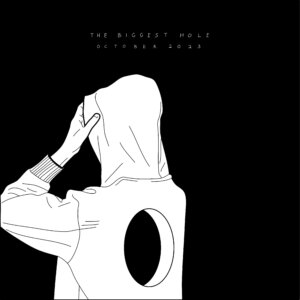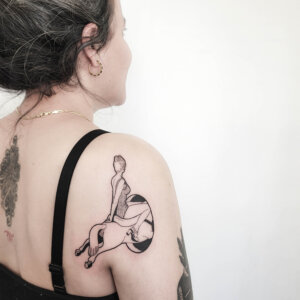After the massacre, a profound abyss that one Tel Aviv tattoo artist is trying to fill with art
Inbal Hoffman used holes as a motif in her art; now they have taken on new meaning

Inbal Hoffman’s art portrays the gaping hole that has opened up at someone’s core. Courtesy of Inbal Hoffman
The day before it all began, Inbal Hoffman was tattooing a client: two hands coming out of a hole, one holding a disco ball. A few days before that, she’d tattooed another client: a child’s arm emerging from a hole to clasp their mother’s hand, a commemoration of the parent the client had lost as a teenager years ago.
On Saturday, Hamas attacked.
By Tuesday, Hoffman was trying to capture the gaping hole Saturday had left in its wake in a series of drawings she’s shared on social media.
The Tel Aviv-based multidisciplinary artist — an illustrator turned T-shirt designer turned installation artist turned tattoo artist — had often used holes in her tattoo designs. The image caught on, and clients started requesting them, with this emerging or that disappearing. With the war, the hole suddenly took on new meaning.
“So much was lost in one minute,” Hoffman told me on a WhatsApp video call from her living room at home in Tel Aviv. “I felt like the hole took us over.”

‘The first thing I did was shut down’
The day of the attack, Hoffman was home “doing Saturday stuff,” puttering around, the usual.
“At first we thought it was, I don’t know, we didn’t know what to think,” she said. “As the hours passed, we kind of felt like, no, it cannot be happening. It cannot be really the truth. And then it became apparent that it is actually happening,” she recalled. “You lose your footing on everything. And it was pretty unstable before.”
For months, she and thousands of other Israelis at home and abroad had been protesting Prime Minister Benjamin Netanyahu’s latest government. “At least protesting had some hope in it,” she said. But it was also very tiring. “It was like a constant battle of moral deterioration all around and it brings you down,” she said. “So we were pretty beaten up.”
And then suddenly, amid the fatigue from that fight, there was war.
Confusion and denial turned into fear. “It’s not only that the house collapsed on you, it’s also that the roots are being ripped beneath you,” Hoffman said. “We knew we can’t rely on our government,” she said. “But we thought we can rely on our army.”
Fear gave way to anger. “Because anger is better than sadness. It’s like a front, like a shield,” Hoffman said, but added the anger felt toxic to her. “Rage is very scary to me,” she said. “I don’t like to feel it. I don’t like it overcoming me.”

‘I needed something that I can process’
After a few days of avoidance, “I tried to make room for the sadness,” Hoffman said. She knew that behind all that anger, her friends were hurting, too. But they didn’t necessarily know how to express that pain.
The images circulating in the news and on social media were horrifying, she thought. “You cannot even process it. I needed something that I can process,” she said. “I needed to give other people something that can bring us to a quiet place where you can feel what’s beneath the anger, which was the sadness.”
That’s when Hoffman started drawing. She picked up her iPad and pen and turned to the hole that had become a motif in her tattoo projects. In the last few weeks, she’s created more than a dozen black-and-white illustrations, most depicting a gaping hole that has opened up at someone’s core.
One figure, shown from the back, lifts their hands to the hood of their sweatshirt, as though tentatively peering out from under it.
A woman perches on a stool, hugging her knees, her ponytail flopping over toward the floor.
Two people embrace.
Three people embrace.
An old man sits, hunched over two grocery bags set down by his feet, one hand holding a forgotten cigarette, as though defeated by the walk home from the store, or by everything else.
A figure walks away with a toddler on their shoulders, tiny fingers sticking out from a sleeve.
Some of the images are posted to social media with animations that show the hole opening up into a dark tunnel or something dripping out from within the hole. But the holes aren’t physical wounds. There are no guns or bullets.
“It’s about being hollow,” Hoffman said.

‘To feel like you’re being echoed’
Hoffman has thought carefully about the role of art, especially when she was a capital-A artist exhibiting work in galleries and museums. “It was necessary for me to understand what I’m supposed to do as an artist,” she said. “What is my job?”
As she sees it, art is meant “to depict the moment, to put it in a bottle, to preserve it for the next generation,” she said. “When art is good, this is what it does. It preserves in a tangible thing something that is elusive right now.”
She insists that she doesn’t think she’s done that here. “I don’t know if 20 years from now this will have any value at all,” she said.
Yet her illustrations have been liked and shared. And many people have reached out to thank her, and tell her she gave voice to emotions they can’t articulate. One commenter wrote (in Hebrew): “Gives me goosebumps. I haven’t seen anything out there that better sums up my feelings right now.”
“It’s a good thing to feel like you’re being echoed,” she said. “You have resonance.”

‘Our situation is so unstable’
After graduating from Bezalel Academy of Arts and Design in Jerusalem, Hoffman got her start making illustrations for newspapers. When that industry became more precarious, she designed a line of printed T-shirts. She took a brief hiatus when she became a mom, then turned to art as a hobby, though it quickly became serious.
“Every time that I feel that I’m cornered, I find a way to change,” she said.
She was poised to have the biggest opportunity of her career — an exhibition at the Israel Museum — in the spring of 2020, but it was postponed for months due to the pandemic. The isolation of the pandemic on top of the loneliness of being a working artist produced a quiet that felt unbearable. She wanted to work with people. So she shifted into tattooing.
“It took me like a year and a half to find my way around. And I think I was in the best place that I could [be] when the war started,” Hoffman said.
When I asked her how she thinks the image of the hole might evolve in her tattooing work, or what she thinks clients might be seeking as they process individual and collective grief, it seemed too hard for her to imagine that future. “You have to understand that our situation in Israel is so unstable that I’m not even sure there is going to be a career after that,” she said.
But that concern is dwarfed by a much bigger one. “I’m not as worried for myself as much as I’m worried for the entire country,” she said. “It can go in so many crazy ways. Bad. Good. No one knows.”
For now, she said, “I’m grateful for every day that I have the ability to draw.” It keeps her busy and sane. And it gives her structure and purpose, trying to give voice to what she and so many others are feeling. She plans to add one drawing to the series every day for as long as she can — and for as long as she feels a personal and communal need amid far too much anguish and uncertainty.
“At least I know what I’ll do tomorrow,” she said.






















